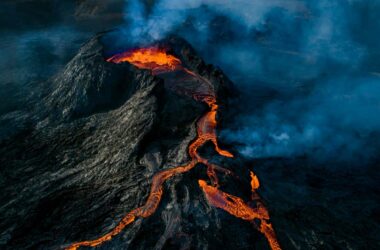Satellite photo of Hunga Tonga-Hunga Haʻapai volcano on 15 January 2022, about 100 minutes after the eruption started
Simon Proud/Uni Oxford, RALSpace NCEO/Japan Meteorological Agency
Introduction
The eruption of the Hunga Tonga-Hunga Haʻapai volcano in Tonga last year had significant impacts both in the atmosphere and underwater. This eruption, considered the most powerful of the 21st century, caused tsunamis and released ash into the sky. While the atmospheric effects were well-documented, the underwater effects remained a mystery.
Uncovering the Impact
Researchers at the National Oceanography Centre in Southampton, UK, led by Michael Clare and Isobel Yeo, decided to investigate the eruption’s impact on the seafloor. They discovered that the eruption triggered a destructive underwater volcanic flow.
During volcanic eruptions, materials like ash and lava are released into the air. Some of these materials fall back down quickly and form a pyroclastic density current. In the case of the Hunga Tonga-Hunga Haʻapai eruption, this material plunged straight into the ocean, creating a powerful underwater current.
Revealing the Findings
By mapping the locations of underwater telecommunication cables and analyzing the damage caused by the eruption, the researchers calculated that the underwater current traveled at a speed of 122 kilometers per hour. They also observed that the current traveled more than 100 kilometers across the seafloor, creating deep grooves along the way.
This observation was a significant breakthrough as it was the first time these underwater flows had ever been observed using modern technology. The study provided invaluable insights into a previously unrecognized hazard.
Implications and Future Preparedness
While it is challenging to prevent the damage caused by volcanic eruptions, understanding the behavior of underwater density currents can help industries such as telecommunications prepare for future events. This newfound understanding may lead to better preparations and strategies to mitigate the impacts of similar volcanic activities in the future.
Scholarly Recognition
The research conducted by the team at the National Oceanography Centre in Southampton has been highly praised. Charles Paull from the Monterey Bay Aquarium Research Institute in California considers the documentation of the eruption’s impact on the seafloor as a remarkable achievement. He believes that this study will be highlighted in geology textbooks for generations as a reminder of the scale of geologic hazards and extreme sediment flows on Earth.








